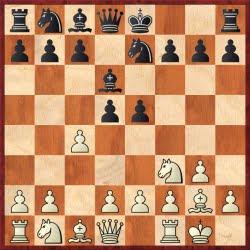The first round saw the first surprises. Some of the rating favourites were knocked down by lower rated opponents. The Russian chess authorities did a doubtful service to their best players by scheduling their national championship just a couple of weeks before the WWCC. Natalia Pogonina was one of the victims of this mental overload. However, the achievement of her opponent Baira Kovanova should not be underestimated.
The greatest surprise of that round was the departure of the European Champion Pia Cramling, who went down against the local Yildiz Betul.
The second round saw also a couple of major upsets, when another Russian player- Tatiana Kosintseva gave way to the Greek Y. Dembo, and unfortunately for me Antoaneta Stefanova had also to leave the stage. After winning her first game against the Chinese Qian Huang, she lost the second, as well as the tie-break. Even though I was not personally in Turkey with Ety, I kept holding my fingers crossed for her, and supported her as well as I could, but some times things just do not work.
The third round was significant as it determined that the chess world will have a new champion. Alexandra Kosteniuk from Russia lost her title in a dramatical tie break against yet another player from China- Lufei Ruan.
In the quarter finals the remaining eight players met, and defined four semi-finalists. Curiously, all of them were from Asia, and three out of these four-Chinese! If you have a look at the pictures from the first round though you may discover how impressive the Chinese group of players/trainers/officials was. Nothing comes by chance in a sport like chess and the success of these two nations should not surprise anyone.
So far the elo favourite Humpy Koneru was winning her matches exceptionally in the normal time, and did not experience the joy of the rapid games. On the other pole was Ruan Lufei who won all her matches in the tie-break.
The top seeded Hou Yifan and Humpy Koneru met in the first semi-final (like they did at the previous WWCC in Nalchik).Despite the fact that the Indian managed to avoid the rapid games again, she had to give way to her younger opponent, just like a couple of years ago in Russian republic. Decisive proved to be the first game in their mini-match:
Hou,Yifan (2591) - Koneru,Humpy (2600) [C67]
2010 WWCC Antakya (51.2), 16.12.2010

This is one of the worst possible scenarious for the second player in the Berlin. She is practically a pawn down on the king's flank, and in addition has weaknesses on the queen's wing, that might ba attacked by the white bishop. 31.Kf3 Bf8 32.g4 Hou opens the diagonal for her bishop. From h4 it will threaten to gain the black pawns on the queen's flank. The other plan is to prepare this advance with h2-h3 first, Kf3-e4, and after g3-g4 White will be threatening to open up the position with f4-f5. If Black swaps the h pawns, Hou can transfer her king to h3, and play with her bishop to h4, followed by Bf6, and Kh3-h4-g5. 32...Be7 Since the pawn endgames are almost always lost, Koneru has to wait patiently. For example: [32...hxg4+ 33.Kxg4 Bh6 34.Bf2 Ke8 35.Bg3 Bf8 36.h4 Kf7 37.h5 gxh5+ 38.Kxh5 Be7 39.Bh4 Bxh4 Otherwise Black loses the queen's side pawns, but now the extra pawn in the center decides. 40.Kxh4 Kg6 41.Kg4 c6

42.f5+! exf5+ 43.Kf4 And Black is in zugzwang. 43...b5 44.axb5 cxb5 45.cxb5 c4 46.bxc4 a4 47.b6 a3 48.b7 a2 49.b8Q a1Q 50.Qg8+ Kh6 51.Qg5+ Kh7 52.Kxf5 and wins.] 33.Kg3 c6 Black should better have avoided this move, as that tempo could be needed in the possible pawn endgame (reserve tempo). [33...h4+ 34.Kh3 followed by Be3-f2xh4 is hopeless for Black.] 34.Kh3 Bd8 35.Bf2 Bc7 36.Bh4 hxg4+ [36...Ke8 37.Bf6 hxg4+ 38.Kxg4 transposes to the game.] 37.Kxg4 Kg7 38.Bf6+ Kf7 39.Bh4 Kg7 40.Bf6+ Kf7 41.Kg5 Zugzwang. 41...b5 [41...Bb8 42.Bd8 Ba7 43.Bc7 Kg7 44.Bd6 Kf7 45.Kh6 and Black runs out of moves.] 42.Kh6 bxa4 43.bxa4 Bb6

44.Be7!? The pawns become more valuable in the endgame, and the young Chinese player realizes that the position had riped for this decisive breaking in. Moreover, the therapeftic measures do not work here: [44.h4 Bc7 45.h5? (However, White can achieve yet another zugzwang, and only then return to the plan with the bishop sacrifice here, to win the game)45... gxh5 46.Kxh5 Bb6 47.Kg5 Bc7 48.f5 Bb6 49.Kf4 Bc7 50.Ke4 Bb6 51.Bh4 Bc7 52.Bf2 Bb6 53.Be3 Ke7 and Black holds thanks to the blockade.] 44...Bc7?! [44...Kxe7 45.Kxg6 Bd8 46.h4 Kf8 47.h5 Kg8 48.h6 Bh4 49.h7+ Kh8 50.Kf7 Kxh7 (50...Bg3 51.Kxe6 Bxf4 52.Kf6 Kxh7 53.e6 White will win back the bishop, as well as the rest of the black pawns.) 51.Kxe6 Kg7 52.Kd7 Kf8 53.f5 Bg3 54.e6 Bh4 55.Kxc6

After writing the annotations for this game I discovered that Black could have saved herself here with the move 55...Kg7!!. I only analysed- 55...Ke7 (55...Be7 56.Kb5) 56.Kxc5 Bg5 (56...Kf6 57.Kd6 Kxf5 58.c5 and White promotes one of the pawns.) 57.Kb5 and the white pawns prevail over the bishop.; 44...Ba7 45.Bd8 will lose even faster.] 45.Bxc5 Hou not only won a pawn, but also activated her bishop. There is one more weakness remaining in the Black's camp, and this proves decisive. 45...Bd8 46.Bf2 Be7 47.c5 Bf8+ 48.Kg5 Be7+ 49.Kg4 Ke8 50.Be1 Bxc5 51.Bxa5 Be7 52.Kf3 Kd7 53.Ke4 c5 54.Kd3 Kc6 55.Kc4 Bh4 56.Bd2 Bf2 57.h3 [57.a5 with the idea to deflect the king would have won immediately, for example: 57...Bg1 (57...Kb7 58.Kb5) 58.h4 Bf2 59.a6 Bxh4 60.a7 Kb7 61.a8Q+ Kxa8 62.Kxc5 Be7+ 63.Kc6] 57...Bg1 58.Bc1 Bf2 59.Bd2 Bg1 60.Kd3 Bf2 61.Be3 Be1 62.Kc4 Bb4 63.Bf2 Kb6 64.Be3 Kc6 65.Bg1 Kb6 66.Bf2 Kc6 67.Bh4 Bd2 68.Bg5 Be1 69.Be7 Bf2 70.a5 Be3 71.Bg5 Bf2 72.h4 Bg3 73.a6 Bf2

74.h5! gxh5 75.f5 exf5 76.e6 Bg3 77.e7 Kd7 78.a7 1–0
Ruan Lufei is the other finalist after winning yet another rapid tiebreak against the compatriot Zhao Xue









